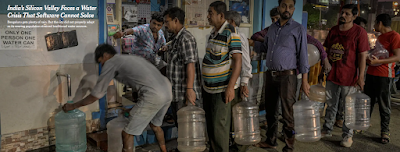Thung lũng Silicon của Ấn Độ đối mặt với khủng hoảng nước khiến phần mềm không thể giải quyết
BBengaluru có nhiều mưa. Nhưng thành phố không thích nghi đúng mức khi dân số tăng vọt gây căng thẳng cho nguồn nước truyền thống
----
The water tankers seeking to fill their bellies bounced past the dry lakes of India’s booming technology capital. Their bleary-eyed drivers waited in line to suck what they could from wells dug a mile deep into dusty lots between app offices and apartment towers named for bougainvillea — all built before sewage and water lines could reach them.
At one well, where neighbors lamented the loss of a mango grove, a handwritten logbook listed the water runs of a crisis: 3:15 and 4:10 one morning; 12:58, 2:27 and 3:29 the next.
The big problem afflicting Bengaluru is not a lack of rain (it gets plenty, about as much as Seattle), but rather what often holds this giant, energetic nation back: arthritic governance. As the city rushed toward the digital future, tripling its population to 15 million since the 1990s and building a lively tech ecosystem, water management fell behind and never caught up as otherwise healthy aquifers were drawn dry by the unchecked spread of urban bore wells (giếng khoan đô thị).
Failures of environmental stewardship are common across a country with severe pollution (ô nhiễm nghiêm trọng) and an acute need for economic growth to provide for 1.4 billion people, spanning political parties and India’s north-south divide. But Bengaluru’s water struggle is especially withering for many — and motivating for some who have water sales or reform in mind — because the city sees itself as an innovator. And in this case, the causes and solutions are well known.
Acknowledging that some past officials had thought narrowly about water management (quản lý nước), he said he hoped to attract public and private money for a more innovative approach, mixing data-driven methods that would revive lakes (hồi sinh hồ) to let aquifers recharge and would expand rainwater harvesting (mở rộng thu gom nước mưa) and conservation.
source: nytimes,



Post a Comment